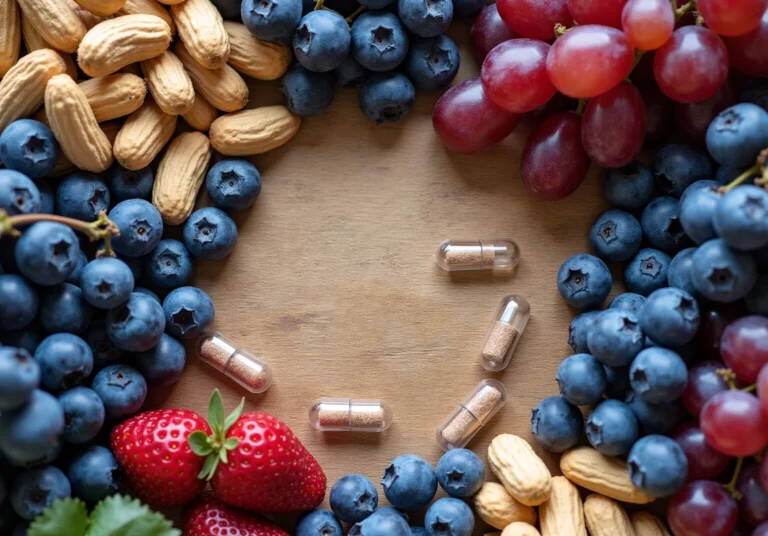7 Key Insights on NMN vs NAD Supplement for Anti-Aging
Overview
This article examines the comparative benefits and roles of NMN (Nicotinamide Mononucleotide) and NAD (Nicotinamide Adenine Dinucleotide) supplements in promoting anti-aging and enhancing cellular health. NMN supplementation is highlighted for its effectiveness in elevating NAD levels, which are essential for energy metabolism and cellular repair. These factors contribute to potential advantages for longevity and overall well-being, a conclusion supported by various clinical studies and expert opinions.
Furthermore, understanding the impact of these supplements can empower individuals to make informed choices about their health. As a result, exploring NMN and NAD supplements may offer pathways to enhance vitality and support healthy aging. Consider delving deeper into the research surrounding these compounds to uncover their full potential.
Introduction
As the quest for longevity intensifies, the spotlight on NMN and NAD supplementation shines brighter than ever. These compounds are gaining traction for their potential to enhance cellular health and combat the effects of aging. But what truly sets them apart? This article delves into critical insights surrounding NMN and NAD, exploring their unique roles and benefits.
We will also examine the latest research findings that could redefine anti-aging strategies. Are these supplements the key to unlocking a healthier, longer life, or do nuances warrant a closer look?
ByKomi: Comprehensive Guide to NMN and NAD Supplementation
ByKomi.com provides a comprehensive guide comparing NMN vs NAD supplement, emphasizing their essential roles in enhancing cellular well-being and promoting longevity. NMN acts as a direct precursor to NAD, a crucial coenzyme involved in energy metabolism, DNA repair, and various cellular processes. Notably, as NAD levels decline with age—by as much as 10% to 80%—the comparison of NMN vs NAD supplement has emerged as a potential strategy to counteract age-related physiological decline.
Recent studies reveal that NMN intake can significantly boost blood NAD levels, with some trials noting increases of up to 38% compared to placebo groups. For instance, a clinical study involving middle-aged individuals demonstrated that NMN not only raised NAD levels but also improved wellness scores and walking stamina, suggesting its potential benefits for physical activity in older populations.
Current trends regarding the NMN vs NAD supplement usage highlight a growing interest in their anti-aging properties, particularly among health-conscious individuals. Experts emphasize that while the comparison of NMN vs NAD supplement can enhance cellular well-being, the clinical benefits may vary. Some studies have indicated improvements in metabolic markers, whereas others show no significant changes in physical performance or insulin sensitivity.
To effectively incorporate NMN and NAD supplements into a wellness regimen, it is crucial to consider optimal dosing and individual conditions. Recommendations suggest starting with smaller doses and gradually increasing them while monitoring any changes in wellness indicators. As research continues to advance, the potential of the NMN vs NAD supplement to support longevity and overall well-being remains an exciting area of exploration.
In conclusion, NMN and NAD support presents an appealing option for individuals seeking to enhance their cellular well-being and combat the effects of aging. With ongoing research and a focus on personalized approaches, these supplements may play a vital role in extending healthspan and improving quality of life.

NMN vs NAD: Fundamental Differences in Cellular Function
NMN and NAD play distinct yet interconnected roles in cellular function. NMN, or nicotinamide mononucleotide, serves as a direct precursor to NAD, meaning it is converted into NAD within the body. NAD is crucial for energy generation, DNA repair, and cellular signaling. Notably, NMN intake effectively increases NAD levels, particularly as they diminish with age.
Research indicates that administering NMN can significantly enhance NAD levels across various tissues. Studies have shown a rapid increase in plasma NMN levels shortly after oral intake. For instance, one study demonstrated that NMN intake improved insulin sensitivity and metabolic well-being in older mice, highlighting its potential as a therapeutic approach for age-associated issues.
Furthermore, NMN’s ability to suppress age-related body weight gain and improve energy metabolism underscores its effectiveness in combating the physiological declines associated with aging. Understanding the connection between NMN and NAD is vital for developing enhancement strategies, particularly when considering the NMN vs NAD supplement debate, as the demand for efficient anti-aging solutions continues to grow.

Benefits of NMN: Enhancing Cellular Energy and Longevity
Nicotinamide mononucleotide (NMN) intake is associated with numerous benefits for well-being, especially in the context of NMN vs NAD supplement, as it enhances cellular energy production and promotes longevity. Research shows that in the discussion of NMN vs NAD supplement, NMN effectively raises NAD+ levels, which are essential for optimal metabolic function and energy balance. For example, a clinical trial with 80 middle-aged adults revealed significant increases in blood NAD concentrations across all NMN-treated groups, with the highest levels found in those taking 600 mg and 900 mg doses. This rise in NAD+ correlates with improved physical performance, as participants exhibited statistically significant increases in walking distance during a six-minute walking test compared to the placebo group.
Furthermore, NMN’s contribution to mitochondrial function is crucial for addressing age-related declines in energy levels. Studies indicate that NMN intake can enhance mitochondrial health, vital for sustaining cellular energy production. In animal models, NMN has demonstrated improvements in muscle function and endurance, suggesting its potential to alleviate age-related physiological decline.
Expert opinions further emphasize the advantages of NMN in the context of NMN vs NAD supplement, with researchers highlighting its role in boosting NAD+ levels, which supports various cellular processes related to energy metabolism and tissue repair. As the population ages, the need for effective anti-aging strategies becomes increasingly critical, and NMN supplementation offers a promising path to enhancing overall vitality and longevity. With ongoing research and emerging evidence, NMN is positioned as a key player in the pursuit of healthier aging.

NAD: The Essential Coenzyme for Metabolic Health
NAD, or Nicotinamide Adenine Dinucleotide, is a crucial coenzyme that plays a significant role in various metabolic processes, including glycolysis, the citric acid cycle, and oxidative phosphorylation. It is vital for energy production, DNA repair, and cellular signaling, establishing it as a cornerstone of metabolic well-being. Research indicates that maintaining optimal NAD levels is essential for overall well-being, particularly as individuals age. For instance, studies have shown that NAD+ levels naturally decrease with age, leading to reduced energy production and increased oxidative stress, which can result in age-associated concerns such as metabolic disorders and neurodegenerative conditions.
Supplementation with Nicotinamide Mononucleotide (NMN) has emerged as a promising strategy in the debate of NMN vs NAD supplement to restore NAD levels, especially in older adults. Clinical trials have demonstrated that NMN can effectively raise NAD+ levels, thereby enhancing mitochondrial function and improving metabolic wellness. A notable study found that daily NMN supplementation significantly increased NAD+ levels in older adults, correlating with improved muscle function and energy metabolism.
Experts underscore the importance of NAD in metabolic well-being, noting that it activates enzymes essential for DNA repair and energy production. Manisha Parulekar, a leading geriatric specialist, emphasizes that “NAD+ is a crucial coenzyme involved in hundreds of metabolic reactions, particularly those related to energy production, DNA repair, and cell signaling.” This highlights the necessity of maintaining sufficient NAD levels to support cellular well-being and longevity.
Incorporating insights from the Hunza people’s dietary practices, which emphasize quality nutrition, can further enhance our understanding of how to support NAD levels. Their diet, rich in whole foods and low in processed products, aligns with the principles of sustaining metabolic well-being through nutrition.
In summary, NAD is not merely a coenzyme; it is a crucial element of metabolic well-being that influences energy production and cellular repair mechanisms. As research continues to unveil its significance, methods to increase NAD levels, particularly through dietary modifications and the comparison of NMN vs NAD supplement, are becoming increasingly important for individuals aiming to enhance their well-being and vitality as they age.

Safety of NMN and NAD Supplements: What You Should Know
Research indicates that when considering NMN vs NAD supplement, both are generally safe for most individuals when taken at recommended dosages. Clinical studies have shown minimal side effects, with doses up to 900 mg of NMN being well tolerated. However, individuals with certain medical conditions should consult healthcare experts before beginning additional nutrients to ensure safety and efficacy.
Furthermore, incorporating personal experiences and scientific insights can further illuminate the benefits and considerations of these supplements. This approach provides a more comprehensive understanding for health-conscious individuals. Are you considering adding these supplements to your regimen? Exploring both the scientific evidence and anecdotal experiences related to NMN vs NAD supplement can help you make an informed decision.

Comparative Effectiveness: NMN vs NAD in Clinical Studies
Clinical studies have demonstrated that NMN intake effectively raises NAD levels in the body, leading to improved metabolic well-being and energy production. In the debate of NMN vs NAD supplement, both show promise in enhancing cellular function; however, NMN is often preferred for its direct role in boosting NAD levels. Furthermore, research indicates that when considering NMN vs NAD supplement, NMN may provide more pronounced benefits regarding energy metabolism and longevity.
As a result, understanding the impact of NMN can be crucial for those seeking to optimize their health. By exploring the benefits of NMN, individuals can make informed decisions about their supplementation choices.

Integrating NMN and NAD Supplements with a Healthy Lifestyle
To maximize the advantages of the nmn vs nad supplement intake, it is essential to integrate these supplements into a healthy lifestyle. This includes maintaining a balanced diet rich in nutrients, engaging in regular physical activity, managing stress, and ensuring adequate sleep. One delicious way to enhance your diet is by preparing ribeye steaks, which are not only flavorful but also packed with nutrients.
Expert Guide to Cooking Perfect Ribeye Steaks:
- Prepare the Steaks: Remove the ribeye steaks from the refrigerator about 30 minutes before cooking to allow them to come to room temperature. Pat them dry with paper towels and season generously with salt and pepper on both sides.
- Heat the Pan: Heat olive oil over high heat in a large cast-iron skillet until it shimmers. Ensure the pan is very hot before adding the steaks.
- Sear the Steak: Carefully place the ribeye steaks in the hot skillet. Sear without moving them for about 4-5 minutes until a golden brown crust forms.
- Add Butter: Flip the steaks and add grass-fed butter to the pan. Use a spoon to baste the steaks with the melted butter as it melts. Continue cooking for an additional 4-5 minutes for medium-rare doneness or longer to reach your desired level of doneness.
- Rest the Steaks: Once cooked, remove the steaks from the skillet and let them rest on a cutting board for at least 5 minutes before slicing. This allows the juices to redistribute, ensuring a juicy steak.
- Serve: Slice the steaks against the grain and serve warm, drizzled with the melted butter from the pan and garnished with fresh herbs if desired.
These lifestyle factors, along with a nutritious meal such as ribeye steak, can improve the efficacy of the nmn vs nad supplement, fostering overall well-being and longevity.

Current Research Trends: NMN and NAD in Anti-Aging Studies
Recent studies have focused on the potential benefits of the NMN vs NAD supplement to mitigate age-related decline and promote longevity. What if these compounds could revolutionize our approach to aging? Research is currently investigating various aspects, including the effects of NMN on cognitive function, metabolic well-being, and cellular repair mechanisms. As the field of anti-aging research evolves, the discussion surrounding NMN vs NAD supplement continues to be at the forefront of scientific inquiry. The implications for healthy aging are promising, encouraging further exploration into their benefits.

Dosage Guidelines for NMN and NAD Supplements: Best Practices
For NMN intake, the suggested dosage typically ranges from 250 mg to 1,000 mg daily. Many experts indicate that older individuals may benefit from larger amounts, especially between 500 mg and 900 mg. Notably, David Sinclair, a prominent longevity researcher, recommends a daily intake of 1,000 mg of NMN. In contrast, NAD supplements generally have a dosage range of 250 mg to 500 mg daily.
It is advisable to start with a lower dose and gradually increase it, observing personal reactions and wellness goals. Possible side effects of NAD intake may include:
- Nausea
- Fatigue
- Headaches
Therefore, consulting a healthcare professional is crucial to customize dosages according to individual health needs and to ensure safe usage, particularly for older adults who may have different requirements.
Furthermore, NAD enhancement has been safely used for decades without instances of toxicity, providing reassurance for those considering these supplements. This evidence suggests that with proper guidance, the use of NMN vs NAD supplement can be effectively integrated into a health regimen.

Debunking Myths: Common Misconceptions About NMN and NAD
Widespread myths about NMN vs NAD supplement include the belief that they serve as a cure-all for aging or that taking higher doses is always more effective. However, it’s important to clarify that, while the NMN vs NAD supplement are vital in promoting healthy aging, they are not miraculous remedies.
Research suggests that excessive dosages do not guarantee better results and may even pose risks. For instance, studies indicate that moderate doses of NMN vs NAD supplement can effectively replenish NAD+ levels without the negative effects linked to higher amounts.
Furthermore, experts emphasize the necessity of integrating these supplements into a comprehensive health strategy, which encompasses:
- Regular exercise
- Balanced nutrition
- Quality sleep
Understanding the underlying science of NMN vs NAD supplement is crucial for their effective and safe use in the quest for longevity.

Conclusion
The exploration of NMN and NAD supplementation presents a promising opportunity for enhancing cellular health and addressing the effects of aging. By grasping the distinct yet interconnected roles of NMN as a precursor to NAD, individuals can make informed choices about their supplementation strategies. The potential benefits of these compounds underscore their importance in promoting longevity and overall well-being.
Recent studies provide key insights into the effectiveness of NMN in elevating NAD levels, which supports energy metabolism, DNA repair, and various metabolic processes. While both NMN and NAD exhibit promise in clinical applications, NMN stands out as a frontrunner in the pursuit of anti-aging solutions due to its direct effect on NAD enhancement. Furthermore, integrating these supplements into a healthy lifestyle—encompassing balanced nutrition and regular physical activity—is crucial for maximizing their benefits.
As research continues to evolve, the implications of NMN and NAD supplementation for healthy aging become increasingly significant. Embracing these findings encourages individuals to actively consider their health strategies. Engaging with the latest research and understanding the science behind these supplements can empower a proactive approach to longevity and vitality, ultimately leading to a more fulfilling quality of life.
Frequently Asked Questions
What are NMN and NAD, and what roles do they play in the body?
NMN (nicotinamide mononucleotide) is a direct precursor to NAD (nicotinamide adenine dinucleotide), a crucial coenzyme involved in energy metabolism, DNA repair, and various cellular processes. NMN intake increases NAD levels, which decline with age.
How does NMN supplementation affect NAD levels?
Research indicates that NMN supplementation can significantly boost NAD levels, with some studies showing increases of up to 38% compared to placebo groups. It has been demonstrated to enhance NAD levels in various tissues.
What benefits are associated with NMN supplementation?
NMN supplementation is linked to enhanced cellular energy production, improved physical performance, and potential benefits for metabolic health. Studies have shown improvements in walking stamina and insulin sensitivity, particularly in older populations.
Are there any observed differences in the effects of NMN and NAD supplements?
While both NMN and NAD support cellular well-being, NMN serves as a precursor that effectively raises NAD levels. Some studies show improvements in metabolic markers with NMN, whereas NAD supplementation may not exhibit the same consistent benefits.
What is the recommended approach to taking NMN and NAD supplements?
It is advised to start with smaller doses of NMN or NAD supplements and gradually increase them while monitoring changes in wellness indicators. Individual conditions should also be considered for optimal dosing.
What is the current trend regarding NMN and NAD supplementation?
There is a growing interest in NMN and NAD supplementation for their anti-aging properties, particularly among health-conscious individuals. Ongoing research continues to explore their potential benefits for longevity and overall well-being.
What are the implications of declining NAD levels with age?
NAD levels can decline by as much as 10% to 80% with age, which may contribute to age-related physiological decline. Supplementation with NMN and NAD is being investigated as a potential strategy to counteract these effects.
How does NMN affect mitochondrial function?
NMN intake is associated with improvements in mitochondrial health, which is essential for sustaining cellular energy production and addressing age-related declines in energy levels.






